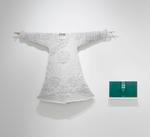Fabrication 3 (2)
Wang Lei
王雷
Production date
2009
Object Detail
Media
paper
Measurements
suit 118 x 150 cm
dictionary 26.5 x 46.5 cm
dictionary 26.5 x 46.5 cm
Notes
For Fabrication No. 3 Wang Lei began by carefully removing pages from an English/Chinese dictionary, then cutting each page into narrow strips. He devised a way to twist and join each dampened strip into long ropes of fibre that could be knitted to form garments. In earlier works he had used toilet paper – deliberately choosing the cheapest and most ordinary of products to make everyday items of clothing, using a technique that is also completely ordinary. “Every woman in China knows how to knit,” says the artist. Later, instead of making contemporary clothes, he fashioned imperial garments – “Dragon Robes” of the Qing Dynasty (1644 – 1911). In the past they were made of silk richly embroidered with dragons, phoenixes, cranes, peacocks and other floral and animal motifs signifying longevity and prosperity. In Wang Lei’s version traditional motifs are knitted into the fabric of the robe, but the riotous colour of the originals is now a muted grey/white. They speak of loss and the ephemerality of power; the empty robe hanging on the wall suggests the absence of those long dead dynastic rulers, the certainty of mortality.The artist’s decision to cut his paper from a dictionary adds another layer of meaning, as the imperial robes and dictionaries alike are symbols of authority that is challenged in the modern world. The artist points out that dictionaries today cannot possibly keep up with how fast language changes, or with new words coined and popularised on the internet. Like the authority of the emperor, their power is no longer absolute. The title suggests that meanings, too can be fabricated and falsified. The new ‘emperors’ in today’s China are politicians and officials so tainted by allegations of corruption and bribery that they are considered untrustworthy.
Accession number
2010.055

